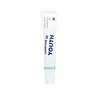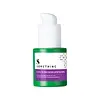What's inside
What's inside
 Key Ingredients
Key Ingredients

 Benefits
Benefits

 Concerns
Concerns

 Ingredients Side-by-side
Ingredients Side-by-side

Water
Skin ConditioningButylene Glycol
HumectantCaprylic/Capric Triglyceride
MaskingCetearyl Alcohol
EmollientCetyl Ethylhexanoate
EmollientPolyglyceryl-3 Methylglucose Distearate
EmulsifyingDicaprylyl Ether
EmollientGlycerin
HumectantGlyceryl Stearate
EmollientPentylene Glycol
Skin Conditioning1,2-Hexanediol
Skin ConditioningCetearyl Olivate
Sorbitan Olivate
EmulsifyingAllantoin
Skin ConditioningHydroxyacetophenone
AntioxidantPalmitic Acid
EmollientStearic Acid
CleansingCarbomer
Emulsion StabilisingBHT
AntioxidantXanthan Gum
EmulsifyingTromethamine
BufferingDisodium EDTA
Retinol
Skin ConditioningPolysorbate 20
EmulsifyingTocopherol
AntioxidantPalmitoyl Tripeptide-1
Skin ConditioningPalmitoyl Tetrapeptide-7
Skin ConditioningWater, Butylene Glycol, Caprylic/Capric Triglyceride, Cetearyl Alcohol, Cetyl Ethylhexanoate, Polyglyceryl-3 Methylglucose Distearate, Dicaprylyl Ether, Glycerin, Glyceryl Stearate, Pentylene Glycol, 1,2-Hexanediol, Cetearyl Olivate, Sorbitan Olivate, Allantoin, Hydroxyacetophenone, Palmitic Acid, Stearic Acid, Carbomer, BHT, Xanthan Gum, Tromethamine, Disodium EDTA, Retinol, Polysorbate 20, Tocopherol, Palmitoyl Tripeptide-1, Palmitoyl Tetrapeptide-7
Water
Skin ConditioningButylene Glycol
HumectantSqualane
EmollientNeopentyl Glycol Diheptanoate
EmollientPentylene Glycol
Skin ConditioningDipentaerythrityl Hexa C5-9 Acid Esters
Skin ConditioningBetaine
HumectantPolyglycerin-3
HumectantEthylhexyl Methoxycinnamate
UV Absorber1,2-Hexanediol
Skin ConditioningCetyl Ethylhexanoate
EmollientHydrogenated Olive Oil Unsaponifiables
Emollient4-T-Butylcyclohexanol
MaskingAllantoin
Skin ConditioningPoloxamer 235
EmulsifyingAcrylates/C10-30 Alkyl Acrylate Crosspolymer
Emulsion StabilisingHydrogenated Lecithin
EmulsifyingXanthan Gum
EmulsifyingRetinol
Skin ConditioningSodium Dilauramidoglutamide Lysine
HumectantPolysorbate 20
EmulsifyingSodium Ascorbate
AntioxidantSodium Phytate
Ethylhexylglycerin
Skin ConditioningEpigallocatechin Gallate
AntioxidantBHT
AntioxidantDisodium EDTA
Phenoxyethanol
PreservativeBHA
AntioxidantTocopherol
AntioxidantWater, Butylene Glycol, Squalane, Neopentyl Glycol Diheptanoate, Pentylene Glycol, Dipentaerythrityl Hexa C5-9 Acid Esters, Betaine, Polyglycerin-3, Ethylhexyl Methoxycinnamate, 1,2-Hexanediol, Cetyl Ethylhexanoate, Hydrogenated Olive Oil Unsaponifiables, 4-T-Butylcyclohexanol, Allantoin, Poloxamer 235, Acrylates/C10-30 Alkyl Acrylate Crosspolymer, Hydrogenated Lecithin, Xanthan Gum, Retinol, Sodium Dilauramidoglutamide Lysine, Polysorbate 20, Sodium Ascorbate, Sodium Phytate, Ethylhexylglycerin, Epigallocatechin Gallate, BHT, Disodium EDTA, Phenoxyethanol, BHA, Tocopherol
Ingredients Explained
These ingredients are found in both products.
Ingredients higher up in an ingredient list are typically present in a larger amount.
1,2-Hexanediol is a synthetic liquid and another multi-functional powerhouse.
It is a:
- Humectant, drawing moisture into the skin
- Emollient, helping to soften skin
- Solvent, dispersing and stabilizing formulas
- Preservative booster, enhancing the antimicrobial activity of other preservatives
Allantoin is a soothing ingredient known for its protective and moisturizingg properties. Because of this, it is often added to products with strong active ingredients.
Studies show higher concentrations of this ingredient can promote wound healing.
Though it can be derived from the comfrey plant, allantoin is produced synthetically for cosmetic products to ensure purity.
Learn more about AllantoinBHT is a synthetic antioxidant and preservative.
As an antioxidant, it helps your body fight off free-radicals. Free-radicals are molecules that may damage your skin cells.
As a preservative, it is used to stabilize products and prevent them from degrading. Specifically, BHT prevents degradation from oxidation.
The concerns related to BHT come from oral studies; this ingredient is currently allowed for use by both the FDA and EU.
However, it was recently restricted for use in the UK as of April 2024.
Learn more about BHTButylene Glycol (or BG) is used within cosmetic products for a few different reasons:
Overall, Butylene Glycol is a safe and well-rounded ingredient that works well with other ingredients.
Though this ingredient works well with most skin types, some people with sensitive skin may experience a reaction such as allergic rashes, closed comedones, or itchiness.
Learn more about Butylene GlycolCetyl Ethylhexanoate is an emollient ester. It comes from cetearyl alcohol and 2-ethylhexanoic acid.
Cetyl Ethylhexanoate is an emollient that adds a velvety feel to skin without being greasy or oily. Emollients help trap moisture into your skin, keeping your skin soft and hydrated.
Disodium EDTA plays a role in making products more stable by aiding other preservatives.
It is a chelating agent, meaning it neutralizes metal ions that may be found in a product.
Disodium EDTA is a salt of edetic acid and is found to be safe in cosmetic ingredients.
Learn more about Disodium EDTAPentylene glycol is typically used within a product to thicken it. It also adds a smooth, soft, and moisturizing feel to the product. It is naturally found in plants such as sugar beets.
The hydrophilic trait of Pentylene Glycol makes it a humectant. As a humectant, Pentylene Glycol helps draw moisture from the air to your skin. This can help keep your skin hydrated.
This property also makes Pentylene Glycol a great texture enhancer. It can also help thicken or stabilize a product.
Pentylene Glycol also acts as a mild preservative and helps to keep a product microbe-free.
Some people may experience mild eye and skin irritation from Pentylene Glycol. We always recommend speaking with a professional about using this ingredient in your routine.
Pentylene Glycol has a low molecular weight and is part of the 1,2-glycol family.
Learn more about Pentylene GlycolPolysorbate 20 is made by combining ethoxylation of sorbitan, ethylene oxide, and lauric acid. It is a mild cleansing agent, surfactant, and emulsifier.
As a surfactant, it helps collect dirt and oils for washing. Emulsifiers prevent oils and water from separating.
Polysorbate 20 also adds scent to a product. Since it is made using sorbitol, it has a sweet scent. Sorbitol can also be found in fruits such as apples and peaches.
The lauric acid used to create Polysorbate 20 is often derived from coconuts.
Polysorbate 20 may not be fungal acne safe.
Learn more about Polysorbate 20Retinol is a gold-standard ingredient for anti-aging. It is a form of Vitamin A and belongs to the class of retinoids that also includes tretinoin.
Why is retinol famous?
It has the most scientific studies backing up its skin benefits out of all the non-prescription ingredients.
Retinol is proven to:
This is why retinol is effective at removing wrinkles, fading dark spots, treating acne, and reducing the appearance of pores.
Studies show retinol is less effective when exposed to UV. Be sure to look for appropriate packaging to keep your retinol potent (similar to Vitamin C).
Using retinol or any retinoids will increase sun-sensitivity in the first few months. Though studies show retinoids increase your skin's natural SPF with continuous use, it is best to always wear sunscreen and sun-protection.
We recommend speaking with a medical professional about using this ingredient during pregnancy.
Retinol may cause irritation in some people, so be sure to patch test. Experts recommend 'ramping up' retinol use: start using this ingredient once a week and work up to using it daily.
Read about Tretinoin
Learn more about RetinolTocopherol (also known as Vitamin E) is a common antioxidant used to help protect the skin from free-radicals and strengthen the skin barrier. It's also fat soluble - this means our skin is great at absorbing it.
Vitamin E also helps keep your natural skin lipids healthy. Your lipid skin barrier naturally consists of lipids, ceramides, and fatty acids. Vitamin E offers extra protection for your skin’s lipid barrier, keeping your skin healthy and nourished.
Another benefit is a bit of UV protection. Vitamin E helps reduce the damage caused by UVB rays. (It should not replace your sunscreen). Combining it with Vitamin C can decrease sunburned cells and hyperpigmentation after UV exposure.
You might have noticed Vitamin E + C often paired together. This is because it is great at stabilizing Vitamin C. Using the two together helps increase the effectiveness of both ingredients.
There are often claims that Vitamin E can reduce/prevent scarring, but these claims haven't been confirmed by scientific research.
Learn more about TocopherolWater. It's the most common cosmetic ingredient of all. You'll usually see it at the top of ingredient lists, meaning that it makes up the largest part of the product.
So why is it so popular? Water most often acts as a solvent - this means that it helps dissolve other ingredients into the formulation.
You'll also recognize water as that liquid we all need to stay alive. If you see this, drink a glass of water. Stay hydrated!
Learn more about WaterXanthan gum is used as a stabilizer and thickener within cosmetic products. It helps give products a sticky, thick feeling - preventing them from being too runny.
On the technical side of things, xanthan gum is a polysaccharide - a combination consisting of multiple sugar molecules bonded together.
Xanthan gum is a pretty common and great ingredient. It is a natural, non-toxic, non-irritating ingredient that is also commonly used in food products.
Learn more about Xanthan Gum